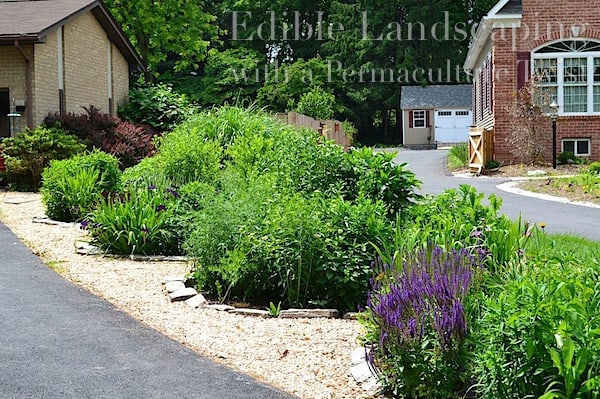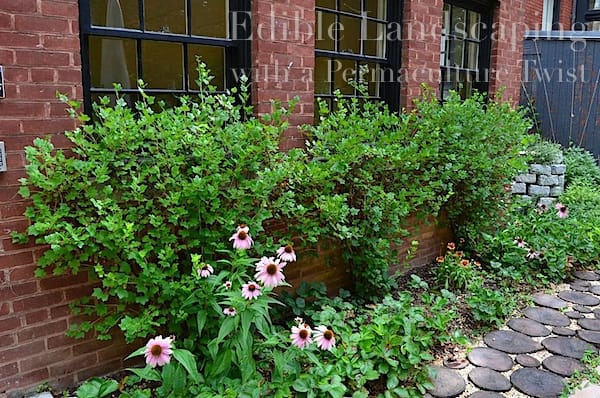In today’s episode of the Grow Edible Podcast, I chat with Michael Judd, the author of Edible Landscaping with a Permaculture Twist about how to create a food forest. Michael has an interesting history; he spent his early adulthood in rural Latin America, including living with a Mayan community in Guatemala. These experiences gave him a unique opportunity to see mature food forests managed by indigenous cultures who have literally thousands of years of experience maintaining sustainable perennial food systems.

Michael’s Easy Step-By-Step Mini Food Forest
In this show, Michael talks about his step-by-step plan to create a food forest, even if you don’t have very much room.
Step One: create a large “patch” of super fertile soil with layered, top-down mulch, including a thick layer of woodchips to feed the fungal layer.
Step Two: Plant your anchor tree in your prepared patch – something like a dwarf apple, a persimmon, or even a large fruit shrub is good if you are very space limited.
Step Three: Surround your anchor tree with four types of perennial support species. Include nitrogen fixers like wild blue indigo or lupin, living mulch “chop-and-drop” plants like comfrey, insect habitat plants like yarrow and pollinator plants like echinacea.
Step Four: make as many patches as your space will allow, allowing them to eventually merge together. If you only have room for one patch, that’s ok too! Even one patch of a tree plus support plants counts as a mini food forest.
Step Five: As you expand, add additional layers to your patch: try edible groundcovers like alpine strawberries or edible vines and brambles like thornless blackberry to add depth and layered texture to your food forest.

Show Notes
Today Michael and I discuss:
- How to make a super fertile soil patch with layers of compost, woodchips and cardboard.
- The psychology of Chop-and-Drop mulching.
- The four categories of companion plants Michael recommends for a food forest “guild”.
- How to adapt the food forest concept to small scale and urban backyard environments.
- Why temperate-climate gardeners need to spread out their food forest plantings to account for lower light-intensity.
- What “sneaky” edible plants you can grow to discourage feral hippies, confuse zombies and fool the HOA landscape committee.
- How to save money implementing a food forest, and where it might not make sense to go the cheap route on your edibles.
- Michael’s favorite unusable edible fruit for vodka infusions.
- Why fruit growers should consider embracing alcohol fermentation as an efficient way to deal with seasonal bounty.

Resources for Today’s Episode
- Michael’s book, Edible Landscaping with a Permaculture Twist.
- Ecologia Design, Michael’s edible and ecological design company.
- A really cool series of videos featuring Michael at Edible Landscaping Nursery in Virginia, sampling unusual fruits and giving tips for how to incorporate these edible choices into a suburban backyard.
- My original review of Edible Landscaping with a Permaculture Twist.

The Giveaway!
Michael has super generously agreed to give away three copies of his book, Edible Landscaping with a Permaculture Twist.
To be entered to win one of three copies of Edible Landscaping with a Permaculture Twist, leave a comment below telling me what your dream food forest would look like!
Contest open until Wednesday, August 27th. Winners will be notified by email and shall have 24 hours to claim their prize. US addresses only due to shipping (sorry international readers!).
Good luck!
Podcast Stuff
Not seeing the podcast player? You’re probably viewing this in your email. Click here to be taken to the web-version of this post, complete with podcast player where you can play or download this podcast.
If you like this new podcast series, you might want to subscribe in iTunes or add the Podcast RSS feed to your preferred podcast reader. If you think I should keep this up, help me grow the podcast by leaving a good review or comment in iTunes – that really helps.
The theme music for the Grow Edible Podcast is Rodeo, graciously provided by my dear friend, the supremely talented Kristen Ward. You can find Kristen’s music on iTunes and Amazon. Rodeo is off the Last Night on Division album – it’s one of my favorites!
Perpetual hat tip to Erik and Kelly of Root Simple, the cool Godparents of the urban homesteading movement. Erik and Kelly put out a sharp and edutaining podcast in addition to writing great books, running a fantastic blog and generally spreading their urban farm wisdom far and wide. They graciously allowed me to steal their phrase “audio companion.”
3
Fruit, fruit, and more fruit! Plus herbs and greens. Everything possible is my dream.
I want to be able to provide part of my families food year round.
I have two small orchard areas – about 30′ x 50′ each that have various common fruit trees and grass. I keep telling my hubby that I want to turn them into food forests and he says no. He would rather mow the grass than have to weed the mulch. Heavy sigh.. But if I could do my food forest . . . .
I have apples, pears, cherries, plums, peaches, hazelnuts, and kiwi. In between them I would plant the blueberries I have in pots, various other berry bushes, and an assortment of herbs. Artichoke, asparagus and rhubarb would find their place. Ground cover alpine strawberries and dry-land cranberries would spot the ground. I would include some native salmon berry, service berry, currant, and huckleberries. I would move some of my comfrey in the mix. The heavy mulch layer would include compost, newspaper, cardboard, hay and wood chips.
But alas, I will have to wait until I can convince dear hubby to try with me . . . . .
Native edibles that allow for wild food foraging while attracting pollinators and birds. Some elderberry along with cattails, wood sorrel, and a variety of herbs.
My dream food forest would combine fruit trees with flowering bushes and nitrogen fixers to not only improve soil composition and nutrient content but provide a source of food for pollinators. Pomegranate, Strawberry Tree and Orange trees, surrounded by ceanothus, salvias, lavender, cuphea, crimson clover.
My dream food forest would have plums, apples, pears, cherries, and peaches as the trees. Under them would be kiwis, pasionfruit, trailing blackberry and green beans/peas as the vines. For shrubs I would have blueberries, cranberries, and lingonberries. As groundcover, there would be pansies, nasturtiums, strawberries, dandelion, other edible weeds, and self-seeding and perennial herbs.
My dream food forest would contain mostly native edible plants and would be sustainable in the Pacific Northwest. I plan on implementing some of these ideas on the mini farm my wife and I just purchased!
Can I do this with trees that already exist? I have 32 fruit and nut bearing trees in my ‘yard’.
Where to begin… my fantasy food forest will hopefully one day be a reality when my partner and I can upgrade to a space with a couple acres.
But in the meantime, our SE Portland city-size yards have been our test space.
I would love to have grapevines and evergreen jasmine (which I will one day successfully propagate from our 7 year old bush) growing around our 30ft chicken run, providing more dappled light and weather protection to our chickens. I would love to see a third keyhole hugulkultur finally exist in the space that we have plotted out, with pea gravel poured in all of our pathways. I want a grafted dwarf apple tree (pink pearl, winesap, & Cox’s Orange Pippin) to live next to our dwarf fig tree, adjacent to our raspberries… where I would plant a [dwarf] filbert tree. Creating a hydroponic system with our downspouts to make a sustainable pond for a few fish is a huge dream that will probably wait for a bigger space, but who knows.
We just started a food forest/fruit tree guild. So far we have two apple trees and a pear. Now I’m working on filling in around them. I have chives, oregano, salvia, and nasturtiums planted but I have a lot of free space still. I dream of filling it all in with raspberries, echinacea, alpine strawberries and lots more delicious helpful plants.
Living in a ground floor condo my options are somewhat limited. I would plant herbs, berries and dwarf fruit trees in the common areas.
Looking out the back of the house, I see the dew sparkling on the new cherry and apple trees. they are surrounded with the strawberries and greens. The blackberries and raspberries are just starting to green up and the collards and cabbages corralling the look gorgeous. Daylilly spears are just popping through the ground around the blueberries. The nut trees and pawpaws are landing guard along the west side of the house to shade the bedrooms, the currents and gooseberries keeping the company. I’m sure the book really help me get this into a workable forest and not just a dream!!
My dream food forest garden in my little semi-arid desert region (SW Idaho) suburban yard would be ‘Cottage garden meets food sufficiency meets low-maintenance green oasis (using as little water as possible). That’s not toooo much to ask, is it? A few small/dwarf fruit trees for shade and enough for canning, berries because – well Berries!! Vegetables and flowers, because the soul and body both need nourished. Herbs, to spice our life. Tomatoes, of course; so many varieties, so little space. Cucumbers, zucchini, beans, lettuce, onions, and there is no life without garlic. (Not in my kitchen anyway.) If there’s any room left over, watermelon and cantaloupes. I would love to have this beautiful book to help me maximize my yard’s potential, and grow my dream. Thank you.
This came at the perfect time as I’m looking to create an edible forest next Spring in our grass covered front parking strip. I was thinking about doing a peach or apples tree, but the goumi bush mentioned caught my interest too. Then plantings of chamomile, echinacea, blueberry bushes, mints, and annual veggies, like bush beans, and leafy greens in the spring/summer. I’m so excited about it!
My dream food forest would have berries and fruit galore! I started last year with blueberries and lingonberries. This year I added strawberries. Now I need to plot out some trees.
My favorite food forest is planting 4 fruit trees in my front yard after I’ve properly prepared the soil with layering. Then plant dwarf fruit trees surrounded by yarrow, blueberries, raspberries, comfrey, rhubarb, wild blue indigo flowers and Echinacea. I love the herb spirals too. All this would eliminate my grass and provide a wonderful habitat for the beneficial insects and bees. Then, I would set up a couple of cone composters to take care of the waste and to fertilize my roses. A gal has to have roses ya know!
I just checked this book out from the library and it’s great. It’s definitely on my to-buy list now. My dream food forest would include apples, plums, pears, and a cherry all supported as a guild – stuff I have the room for but haven’t known where to start before reading the book. I’d love to try some of the interesting fruits in his book too, like the paw paw or gooseberry.
My dream food forest is full of things you’ve never heard of, and things that you see everyday in the market. My food forest would be a place of sustinence for my family, a class room for my daughter, and a place to reconnect with the Earth.
Cannot wait to have one!
I dream of having figs and persimmons, and berries galore! I love the idea of layers of life intermingling. I’d like to lie down on a carpet of chamomile surrounded by herbs and lovely comfrey, underneath the dappled shade of a fruit tree, the sound of a bubbling water feature nearby, and ducks waddling through. sigh. happy place. 🙂
So, have I won yet?!? 😛
Sooo many things i’d love to do. I’m not a person into flower gardens,I dream of a garden of edibles. <3 Would to have a bunch of berry bushes and plans, along wit climbing beans and veggies on my fences. So many dreams. 🙂
More blueberries and thornless raspberries plus a nut tree and an olive tree .
We already have some great fruit trees. I’d like to add in all the things we really love to eat…tomatoes, strawberries, blackberries, cucumbers, melon, squash & beans.
I’d love a food forest that always had some fruit ready to pick and ingredients for a salad. And colorful flowers with butterflies and bees hovering around and chickens scratching in the mulch. Somehow magically the chickens wouldn’t eat all the food.
I’m trying to create an edible oasis, a medicine cabinet, a nature preserve and a relaxing retreat. It’s a place where deciding what to eat is what I can harvest from the garden for long term health. I have 7 fruit trees, lots of herbs and annual veggies, and I will over double the amount of plants this fall. Always hungry for permaculture/plant talk! Thank you!
Just received my copy of Michael Judd’s book! Already done a preliminary reading and started taking notes! Beginning the design process and thinking about what we’ll do first! Thank you, thank you, thank you!
I just listened to this podcast but couldn’t figure out what kind of berry he was talking about. Sounded like “gumi” or “gooney” or something like that? I’ve googled those names though and nothing comes up. Was hoping to find the name in the show notes but they’re less specific than I thought they be…..
Goumi. Here’s info: http://www.raintreenursery.com/Berries/Goumi/
looks really good , thank you so much, we gratefully appreciate you , sending blessings from the team at Food forests for healing, health & peace https://www.facebook.com/Food-forests-for-healing-health-peace-347638495382415/